| | Purpose of survey | Methodology | Survey results | Specialty crops by census division in Alberta | Markets for selected specialty crops | Economics of specialty crop production | Acknowledgment | Contact
.
Purpose of Survey
To address some of the data and information needs of the specialty crop industry in Alberta, the Statistics and Data Development (SADD) Section of Alberta Alberta Agriculture and Forestry conducts an annual specialty crop survey. Now into its twenty-seventh year, the survey captures data on area, yield and production for specialty crops grown in the province.
Data gathered from the survey are used primarily to generate related provincial and sub-provincial (Census Division) estimates. In turn, these estimates are used to validate some of the Alberta statistics produced by Statistics Canada, as well as to provide industry and other stakeholders with benchmark data for some of the “new” and emerging crops.
Methodology
The Alberta Specialty Crop Survey, which is provincial in scope, collects data through a non-probability sampling procedure. In January 2010, survey questionnaires were mailed out to 3,467 specialty crop producers across the province. The questionnaires specifically asked survey participants to provide information on the type of specialty crop grown, area (seeded and harvested acres), and yield for 2009. Survey participants were informed that participation in the survey was voluntary. Moreover, all individual responses are kept confidential under the provisions of the Federal Statistics Act, as well as under the Provincial Freedom of Information and Protection of Privacy (FOIP) Act. As of June 7, 2010, a total of 861 questionnaires were returned. Of this total, 735 were usable and partly formed the basis in the generation of the Alberta 2009 specialty crop estimates.
Survey responses received were reviewed for data completeness, validated and entered into an electronic database. The data was then subjected to computerized analyses, the results of which were rolled up into group summaries, to preserve data confidentiality of individual survey respondents. In turn, the group summaries, in conjunction with information from provincial specialists of Alberta Agriculture and Forestry, industry, and published sources (e.g. Statistics Canada), were used to generate the provincial and sub-provincial (Census Division) estimates, where appropriate.
It cannot be over emphasized that extensive consultation is done with Alberta Agriculture and Forestry’s provincial specialists and industry in the development of the provincial/sub-provincial estimates. Provincial specialists are acknowledged for the invaluable insights they offer on crop conditions and yields, particularly when attempting to firm up some of the sub-provincial estimates generated from the survey. Similarly, administrative data on yield and crop area grown under private contracts also add value to the estimates.
It should be noted that the estimates are subject to error. Some of the possible sources of error include data coding, data entry and tabulation. Nonetheless, we believe that the statistics published in this report are reliable estimates for Alberta.
Survey Results
Area, yield and production in Alberta
The six major crops grown in Alberta refer to wheat, barley, oats, rye, canola and flaxseed. All other field crops, excluding vegetables and tame hay, are considered as specialty crops. They include dry peas, chick peas, dry beans, fababeans, lentils, mustard seed, sunflower seed, grain corn, silage corn, triticale, canary seed, sugar beets, potatoes, forage seeds and other field crops.
In 2009, there were significantly more acres seeded to specialty crops, compared to a year earlier. This was mainly due to the need for crop rotation and diversification, as well as good economic returns for some specialty crops. The total provincial seeded area, excluding potatoes and forage seeds, was estimated at 1.24 million acres, up 20 per cent, from 1.03 million acres in 2008 (see Figure 1). Of the total seeded area, over 1.11 million acres or 89 per cent were harvested for grain production. To offer some perspective, shown in Figure 3 on page 4 is the percentage distribution of specialty crop seeded acreage in 2009, by crop type (i.e., pulse crops, oilseeds, corn, forage seeds, and other crops).
The cool, dry weather conditions during much of the 2009 crop season took a toll on crop yields and reduced harvested area in most areas of the province. The exception was southern Alberta, where precipitation ranged from average to above average.
The provincial average yield for dry peas in 2009 was estimated at 32.7 bushels per acre, four per cent lower than in 2008, and 15 per cent below the 10-year average (see Tables 1 and 4). For triticale, the provincial average yield was 50 bushels per acre, eight per cent lower than in 2008, but still 21 per cent above the 10-year average. With the majority of its acreage in southern Alberta, mustard seed produced an average yield of 915 pounds per acre, or 17 per cent higher than in 2008, and 24 per cent above the 10-year average.
The estimated provincial average yields for specialty crops under irrigation ranged from near average to above average (see Tables 1 and 4). For dry beans, the provincial average yield was estimated at 2,080 pounds per acre, or four per cent lower than the 10-year average. The provincial average yield for sugar beets was 24.4 tonnes per acre, compared to 21.6 tonnes per acre for the 10-year average. For potatoes, the provincial average yield was 322 cwt per acre, or two per cent below the 10-year average.
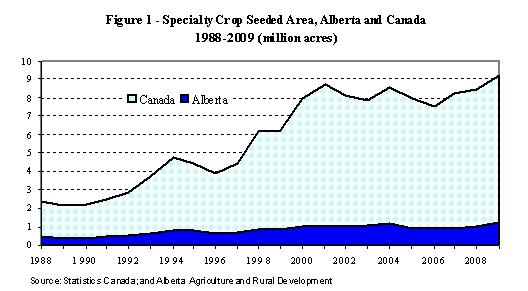
Specialty crops in Western Canada
Based on the results of “Alberta 2009 Specialty Crop Survey” and Statistics Canada’s “November Estimate of Production of Principal Field Crops, Canada, 2009”, total seeded and harvested acres of specialty crops in Western Canada in 2009 increased from a year earlier. This stemmed from larger areas in all provinces in Western Canada.
In 2009, the total seeded area of specialty crops in Western Canada was estimated at 8.49 million acres, up eight per cent from 7.88 million acres in 2008. On a provincial basis, Saskatchewan with its 6.13 million acres, accounted for 72 per cent of the Western Canada total, while Alberta and Manitoba accounted for 15 per cent and 13 per cent, respectively. The specialty crop seeded area in British Columbia was extremely small. Similar to seeded area, the total harvested acreage in Western Canada in 2009 increased six per cent from a year earlier, to 8.07 million acres.
Based on seeded area, the four largest specialty crops grown in Western Canada in 2009 were dry peas, lentils, mustard seed and canary seed. When combined, these crops accounted for seven million acres, or 82 per cent of the total area seeded to specialty crops. Dry peas was the largest specialty crop, accounting for 3.76 million acres, or 44 per cent of the Western Canada total. Lentils was next, with seeded acres totaling 2.40 million acres (28 per cent of the total), while mustard seed and canary seed represented six per cent and four per cent, respectively. Shown in Figure 2 below is the harvested area of the top four specialty crops in Western Canada. Historical statistics on seeded area and production for selected specialty crops are presented in Table 5 on page 13.
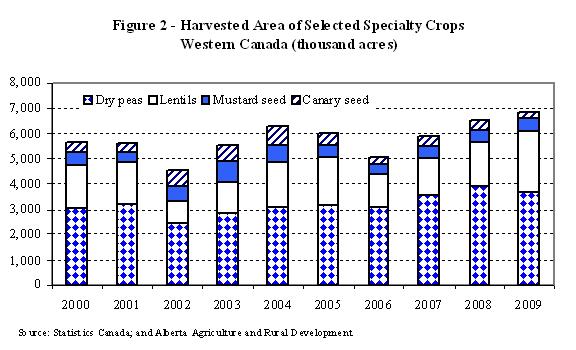
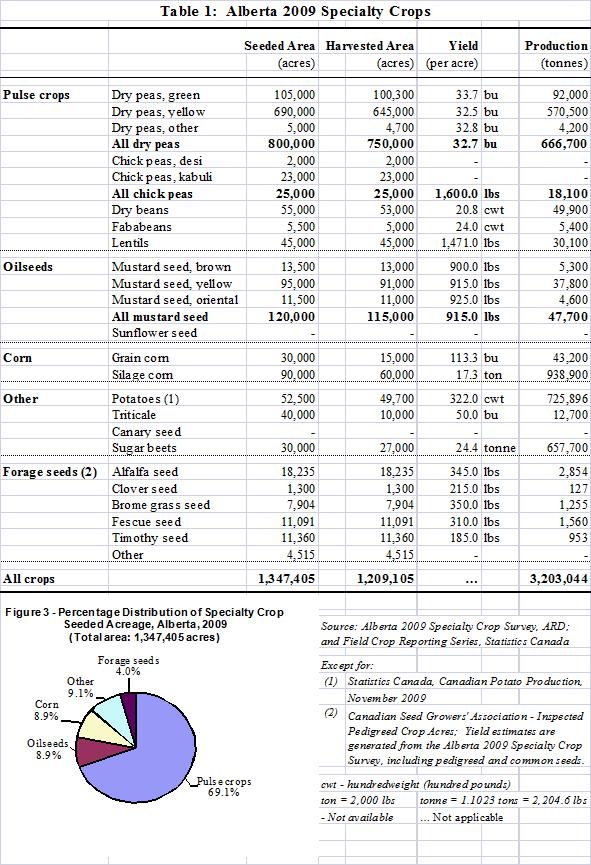
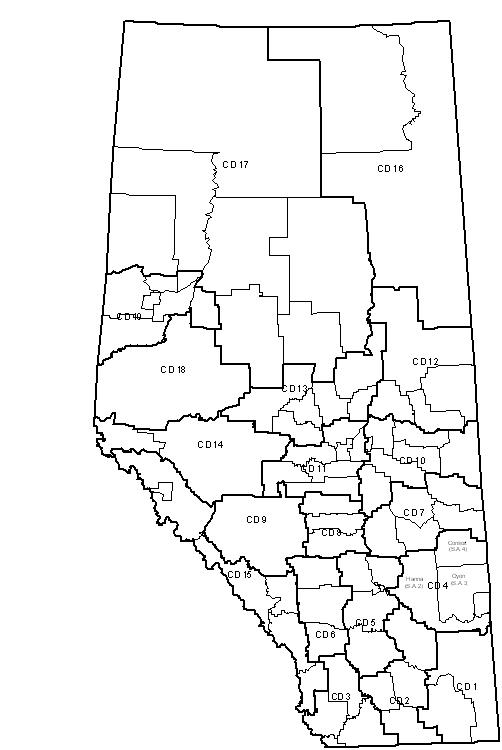 Figure 4
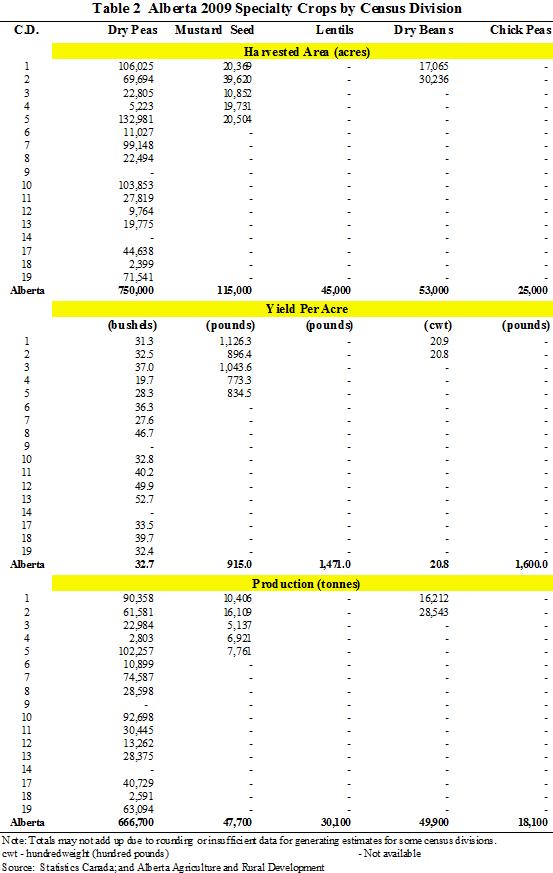
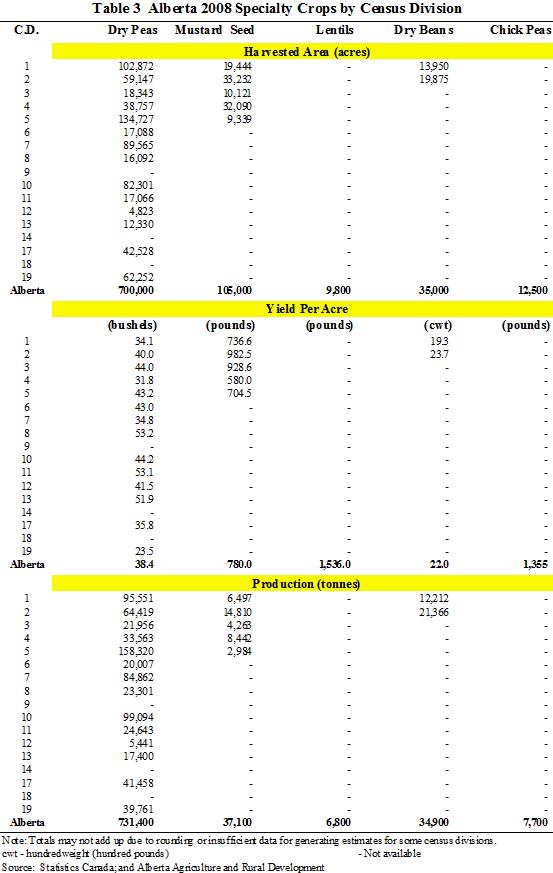
Specialty Crops by Census Division in Alberta
This section presents estimates of area, yield and production at the Census Division level in Alberta, for dry peas, mustard seed, and dry beans. Just to note, the Census Division estimates were generated from a small sample, and as such, caution should be exercised when interpreting and using the data. Also, for reference, the Alberta Census Division and municipality map is shown on page 5 – Figure 4.
Dry peas
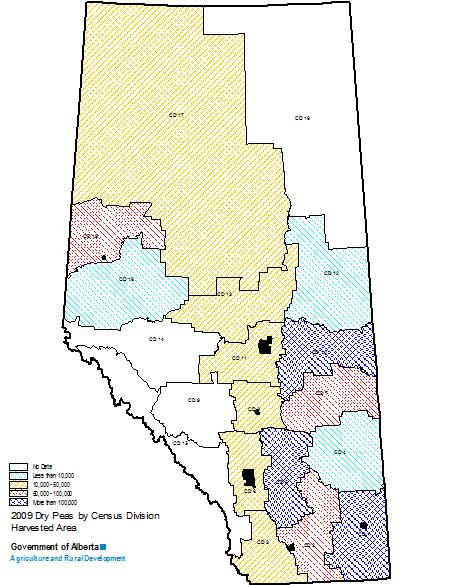
The total seeded area of dry peas in 2009 reached a record 800,000 acres (see Table 1), up 13 per cent from a year earlier. Of the total seeded area, a historically high 750,000 acres were harvested. Due to unfavorable crop growing conditions, the provincial average yield declined 15 per cent from 2008, to 32.7 bushels per acre.
The total provincial production of dry peas was estimated at 666,700 tonnes, down nine per cent from the record production of 731,400 tonnes in 2008. This was attributed to the lower yield, which more than negated the larger harvested area.
Although dry peas are grown primarily on dryland across the province, the largest acreages are in Census Divisions 1 (Medicine Hat area), 5 (Drumheller area), and 10 (Vegreville area) - see Table 2 and Figure 5. In 2009, these three Census Divisions (1, 5 and 10) accounted for 46 per cent of the provincial total harvested area. Just to note, dry pea yields were quite varied across the province.
Mustard seed
In 2009, a total of 120,000 acres were seeded to mustard seed (see Table 1). Of this total, 115,000 acres were harvested, up ten per cent from 2008. The provincial average yield was estimated at 915.0 pounds per acre, or 17 per cent higher than in 2008. Mustard seed is mostly grown on dryland in southern Alberta, where precipitation in2009 ranged from average to above average, contributing to the higher yield.
The total provincial production of mustard seed was estimated at 47,700 tonnes, up 29 per cent from 2008. The higher production stemmed from a combination of higher yield and an increase in harvested area.
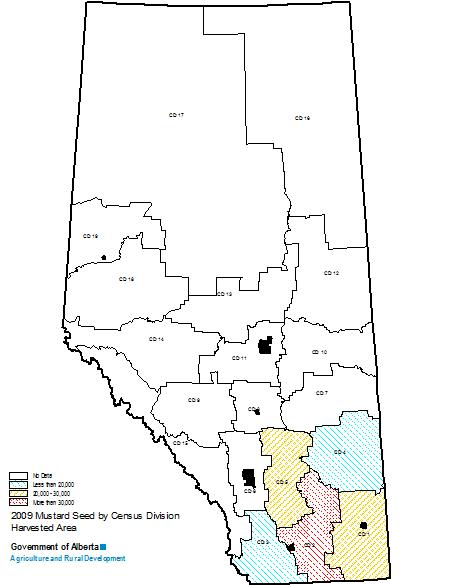
Of the three types of mustard seed produced in Alberta, yellow mustard seed continues to dominate, accounting for 79 per cent of the provincial total production in 2009, while brown mustard seed and oriental mustard seed represented 11 per cent and ten per cent, respectively.
In 2009, nearly 62 per cent of the total harvested area in the province was in Census Divisions 1, 2 and 3 (see Table 2 and Figure 6). Also, mustard seed yields varied significantly across Census Divisions. For example, Census Division 1 had the highest yield of 1,126 pounds per acre, while the lowest yield of 773 pounds per acre was in Census Division 4.
Dry beans
In 2009, producers in the province seeded a total of 55,000 acres of dry beans (see Table 1). Of the total seeded area, 53,000 acres were harvested, up 51 per cent from 2008. The provincial average yield was estimated at 2,080 pounds per acre, down five per cent from 2008 and four per cent below the 10-year average.
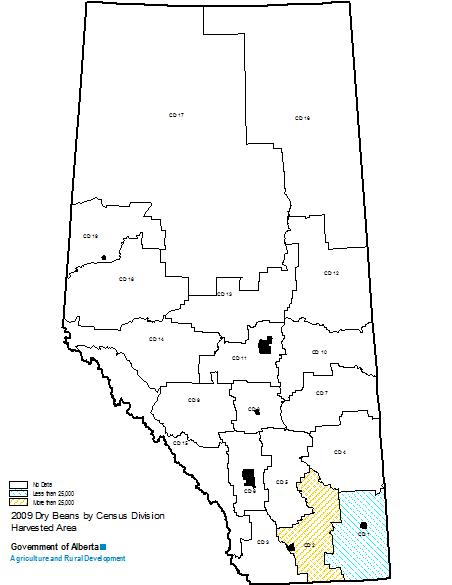 Total production of dry beans in 2009 jumped 43 per cent from a year earlier, to 49,900 tonnes. The higher production was attributed to the substantial increase (51 per cent) in harvested area.
Total production of dry beans in 2009 jumped 43 per cent from a year earlier, to 49,900 tonnes. The higher production was attributed to the substantial increase (51 per cent) in harvested area.
Dry beans are grown mostly under irrigation in southern Alberta. In 2009, a total of 42,674 acres or 78 per cent of the provincial dry bean seeded area was irrigated, according to information from the Water Resources Branch of Alberta Agriculture and Rural Development.
Additionally, Census Divisions 1 and 2 collectively accounted for 89 per cent of the provincial total harvested area (see Table 2 and Figure 7). Dry beans are generally grown under contract in Alberta.
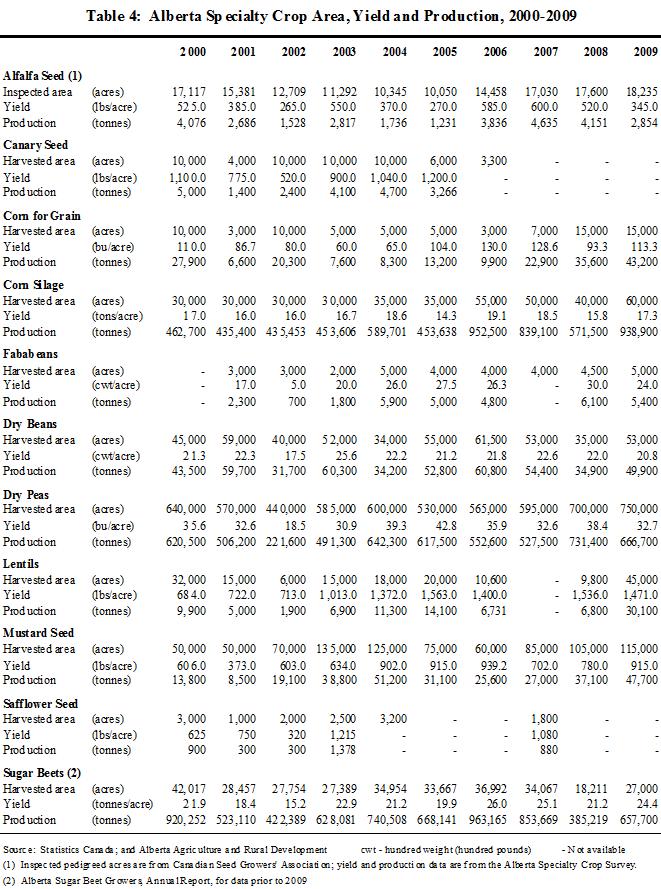
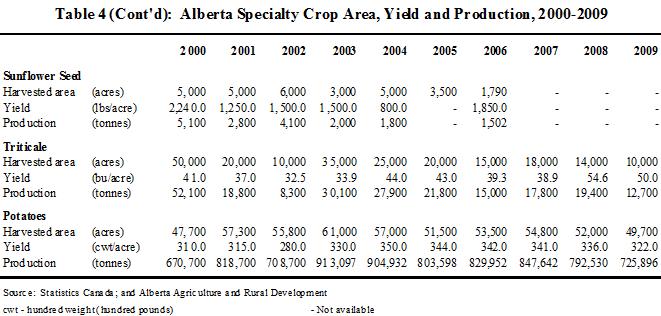
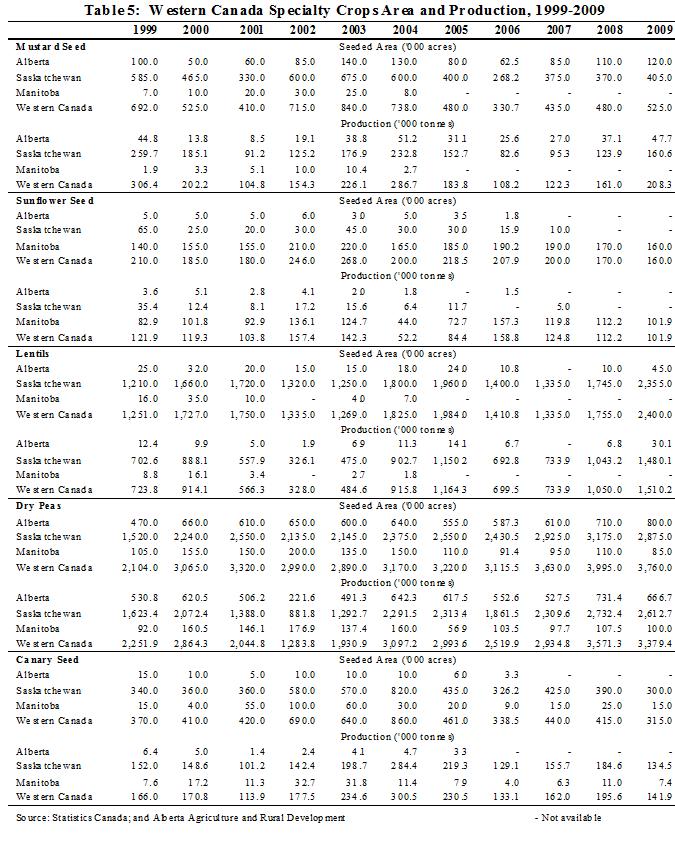
Markets for Selected Specialty Crops
Charlie Pearson
Field peas
Yellow edible pea prices have held in the $4.50 to $6.00 per bushel range over much of the past crop year, slightly below the $5.50 to $6.00 per bushel range in 2008/09. Feed peas held around the $5.00 per bushel area.
The major factor in the lower price levels was the 3.4 million tonne Canadian field pea crop produced in 2009. Canadian pea exports are likely to be about 2.4 million tonnes, down slightly from 2008/09. Domestic disappearance is forecast to be about 800,000 tonnes. Field pea carryovers on July 31, 2009 are forecast to be close to 800,000 tonnes, nearly double the amount stored during the summer of 2008.
Statistics Canada estimated that farmers seeded 3.4 million acres to peas this past spring, down 10 percent from 2009. Lower acres reflected impact of the extremely wet spring seeding period on farmers’ ability to get crop planted.
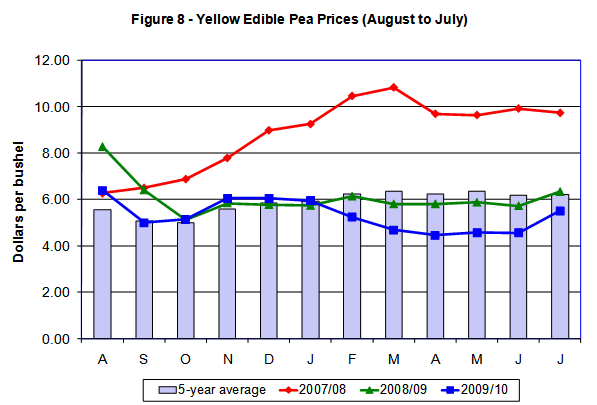
Lentils
Large seeded green lentils have mainly held in the 28 to 36 cent per pound range over the past year. Western Canadian lentil production in 2009 was estimated to be 1.5 million tonnes, up from one million tonnes in 2008. A large export program will mean Canada will effectively be sold out of lentils by the end of the crop year.
Statistics Canada estimated that Saskatchewan farmers seeded a record 2.9 million acres to lentils this past spring. Currently, new crop bids are ranging from 22 to 25 cents per pound for top grade green lentils.
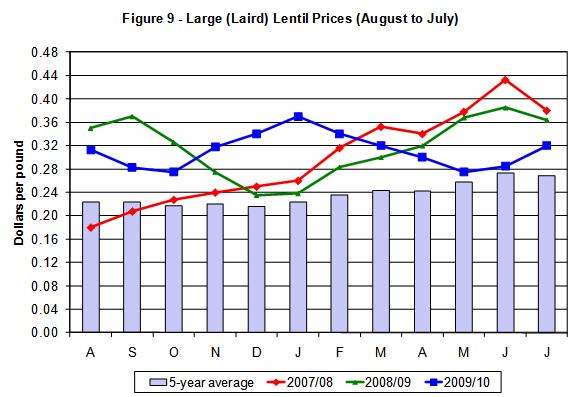
Chickpeas
Kabuli chickpea prices have mostly held in the 25 to 30 cent per pound range over the past winter/spring, slightly below the 5 year average. Western Canadian chickpea production in 2009 is estimated to be 76 000 tonnes, up 13 percent from 2008.
Saskatchewan chick pea acres in 2010 are forecast to be 150,000 acres, up from 80,000 acres in 2009. New crop prices at the time of writing (August) are in the 27 to 30 cent per pound range for 9 millimeter kabuli chickpeas and 24 to 26 cents per pound for desi chickpeas.
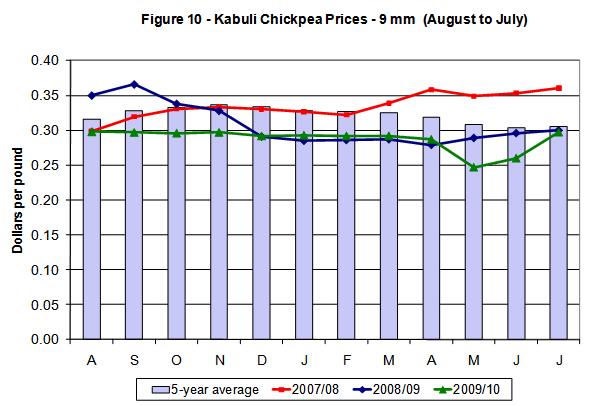
Canary seed
Western Canadian canary seed prices slipped into the 14 to 19 cent per pound range over the past winter and spring, down slightly from the previous year. Canadian canary seed production in 2009 is estimated to be 142,000 tonnes, down almost 28 percent from 2008.
Canary seed acres are estimated to be 310,000 acres in 2010, similar to 2009. Current new crop prices are in the 18 to 19 cent per pound range.
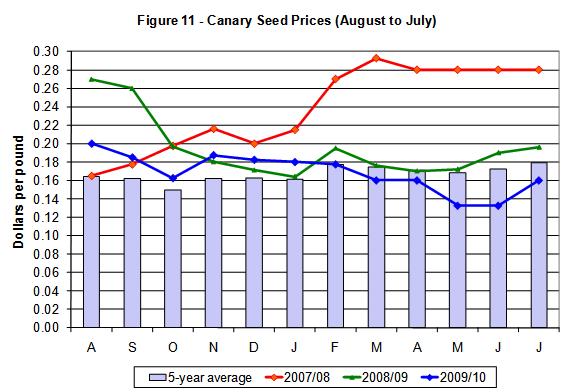
Mustard seed
Western Canadian mustard production is estimated by Statistics Canada to be 208,000 tonnes, up almost 30 percent from 2009. Total supplies (including July 31, 2008 carryover) are 254,000 tonnes.
Saskatchewan and Alberta farmers planted about 410,000 acres to mustard this past spring, down about 22 percent from 2009. Canadian mustard seed supplies will remain tight in the coming crop year. New crop bids are in the 20 to 21 cent per pound range for yellow mustard and 17 to 19 cents per pound for brown and oriental mustard.
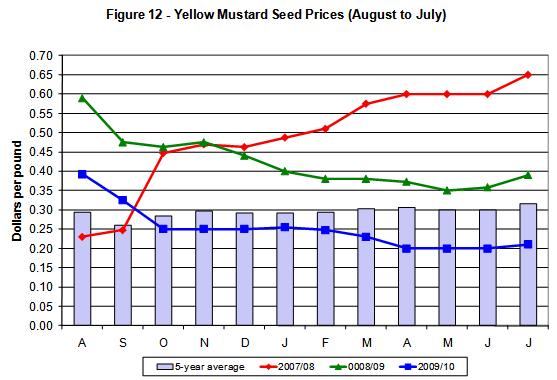
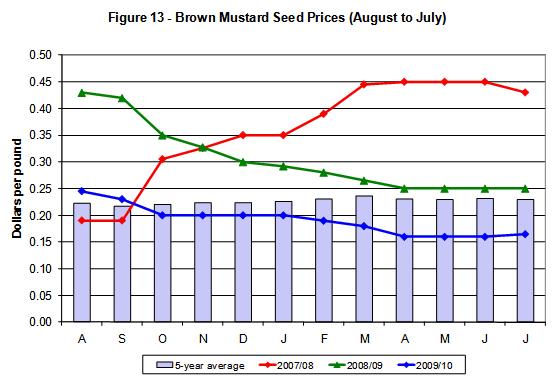
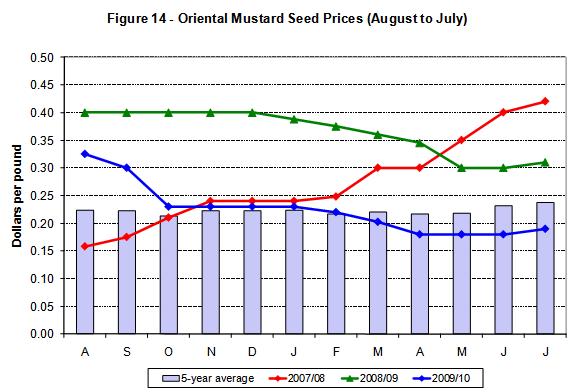
Economics of Specialty Crop Production
.
Nabi Chaudhary
Costs and returns for crops, livestock, and several other enterprises have been monitored in the province in an extensive way since the 1960’s. These studies have been viewed as an important tool for assisting producers in their cropping decisions and the federal and provincial governments in developing policies and programs for different farm enterprises. In addition, results from these studies have served to fill some data gaps for other provinces.
The Economics Branch (formerly known as Production Economics Branch), in the Economics and Competitiveness Division of Alberta Agriculture and Rural Development, has been conducting economic studies on various farm enterprises for the last several decades. Since the early 1990’s, much greater emphasis has been placed on developing costs and returns data on specialty crops for farm diversification purposes.
Continued volatile markets for traditional cereals and oilseeds have forced producers to diversify their operations into new and emerging specialty crops. As mentioned above, results from these studies have been very helpful to primary producers when making cropping decisions. Furthermore, individual producers have also used the results from these studies to compare costs and returns and profitability margins of their farms with the group averages from the respective areas in order to develop better management practices. Agri-businesses and other stakeholders have used the results of the economic studies for feasibility studies.
During the last ten years, area under special crops has increased significantly in Alberta. The total seeded area of dry filed peas was 385,000 acres in 1997, and jumped to 610,000 acres in 2001. In 2002, seeded area increased seven per cent to 650,000 acres. However, seeded area declined to 600,000 acres in 2003. In 2004, seeded area was estimated at 640,000 acres, an increase of about seven per cent over 2003. The seeded area in 2005 decreased 13 per cent, to 555,000 acres. In 2006, seeded area for dry peas increased six per cent, to 587,263 acres. The total harvested area in 2006 was 565,000 acres, or 96 per cent of the seeded area. Provincial average yield for the 2006 dry peas crop was 35.9 bushels per acre. Seeded area to dry peas increased by about four percent over in 2006 to 610,000 acres in 2007. Seeded area increased by 100,000 acres in 2008 from the previous year. Seeded area to dry peas was almost 800,000 acres in 2009, a whopping increase of 190,000 acres over in 2008. Average provincial yield for the 2009 dry peas was estimated at 32.7 bushels per acre, almost six bushels lower than in 2008.
Dry beans acreage in Alberta has fluctuated over the last decade. The total seeded area was 60,000 acres in 2001, and remained unchanged in 2002. It decreased about 13 per cent, to 52,000 acres in 2003. The acreage continued to decline, and totaled 35,000 acres in 2004. In 2005, the total seeded area was estimated at 57,000 acres, an increase of almost 63 per cent over 2004. The acreage in 2006 jumped to 62,039 acres, or nine per cent higher than in 2005. Of the total seeded area in 2006, 61,500 acres were harvested, with an average yield of 2,180 pounds per acre. In 2007, area seeded to dry beans decreased quite significantly by about 15 percent to 52,900 acres. Area seeded to dry beans in 2008 further decreased by over 24 percent to 40,000 acres. In 2009, area seeded to dry beans increased to 55,000 acres, an increase of almost 38 percent over in 2008. Average yield for the 2009 dry beans crop was estimated at 2,400 pounds per acre, around 200 pounds more than in 2008. Please note most of the dry beans are grown under contract on irrigated land in southern Alberta.
In the late 1990’s, producers showed considerable interest in chickpeas (known as the new Cinderella crop on the Prairies). Chickpeas were a huge crop in Saskatchewan from 1999 to 2001, occupying almost one million acres. In Alberta, acreage under chickpeas was 100,000 acres in 2001, double the acreage in 2000. However, the area under chickpeas decreased drastically to 45,000 acre in 2002, primarily due to drought concerns and disease problems. In 2003, the acreage dropped to 25,000 acres. The decline in area continued in 2004, with a total of 15,000 acres, the lowest area on record. In 2005, the total seeded area doubled, to 30,000 acres. In 2006, it increased about 37 per cent to 40,749 acres. Of this total seeded, 40,000 acres were harvested, with an average yield of 1,433 pounds per acre. In 2007, area seeded to chickpeas increased to almost 50,000 acres, i.e., by almost 23 percent over in 2006. In 2008, area planted to chickpeas decreased considerably as Statistics Canada had only a few producers to report. Therefore no actual area figure was published for 2008 as the number of producers reporting on seeding chickpeas was quite small. However, in 2009 area under chickpeas was estimated at 25,000 acres. Average yield for the 2009 chickpeas crop was estimated at around 1, 600 pounds per acre. The changes in chickpea acreage over the last decade could be attributed to drought concerns, crop diseases, and production of major importing countries.
Additionally, producer interest in other specialty crops, including caraway, buckwheat, coriander, borage, herbs and spices, continues to grow.
Shown in Tables 6 are estimates of 2009 production costs and returns for dry peas. Costs and returns data for dry beans and chickpeas (desi and kabuli) are presented in Tables 7 and 8, respectively.
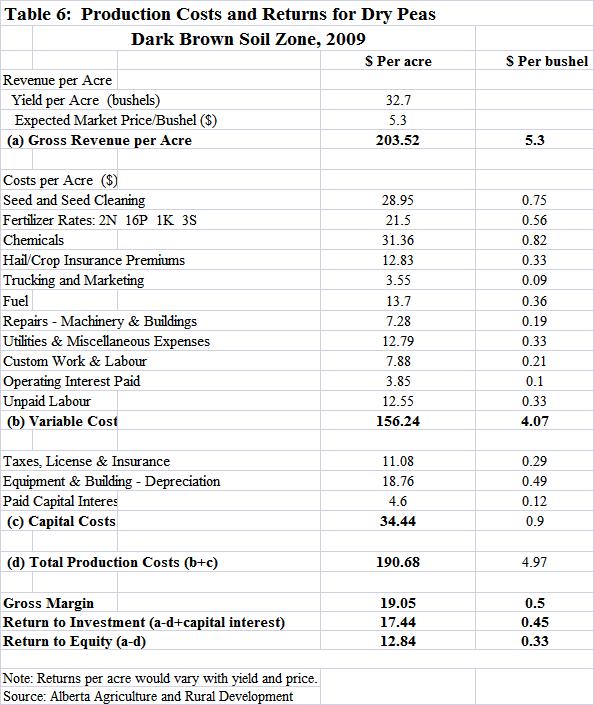
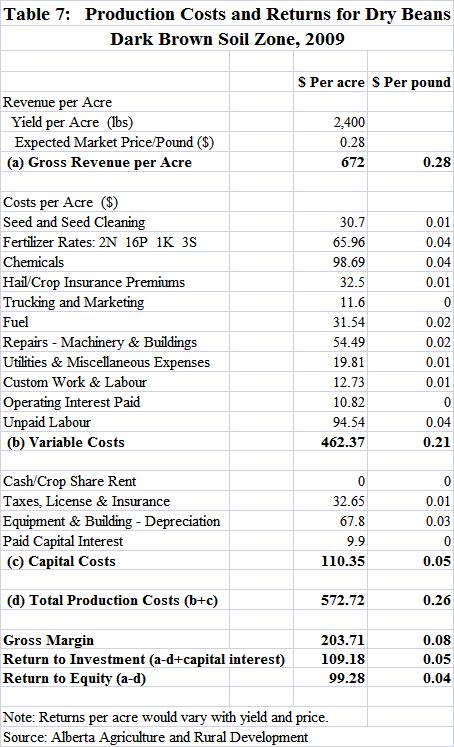
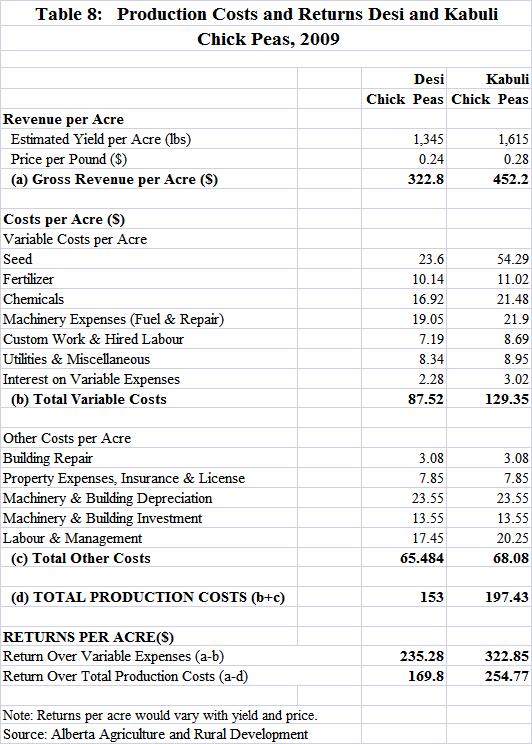
Acknowledgment
The Statistics and Data Development Section of Alberta Alberta Agriculture and Forestry wishes to thank all of the producers who participated in the Alberta 2009 Specialty Crop Survey conducted in the winter of 2009/2010. Without their cooperation and assistance, this report would not have been possible.
Several Alberta Agriculture and Forestry staff members have made significant contributions to the successful completion and dissemination of this report. Those staff include Charlie Pearson of Competitiveness and Market Analysis Branch, Nabi Chaudhary of Economics Branch, Reynold Jaipaul, Roy Larsen, Melodie Mynzak, Guangzhi Liu, Gail Atkinson, Ann Stankiewicz and Marian Elson of Statistics and Data Development Branch.
Chuanliang Su
Crop Statistician
Alberta Agriculture and Forestry
Economics and Competitiveness Branch
Statistics and Data Development Section
#300, 7000 -113 Street
Edmonton, Alberta T6H 5T6
Phone: 780-422-2887
Fax: 780-427-5220
Contacts
For additional information relating to the various sections of this report, please do not hesitate to contact the subject area specialist referenced under each section.
This report is also available on the Internet at:
http://www1.agric.gov.ab.ca/$department/deptdocs.nsf/all/sdd12584
For additional copies of this report, please contact:
Alberta Agriculture and Forestry
Economics and Competitiveness Branch
Statistics and Data Development Section
#302, 7000 -113 Street
Edmonton, Alberta T6H 5T6
Phone: 780-422-2887
Fax: 780-427-5220
Full report in pdf file |
|